
The Auckland Islands are an archipelago of New Zealand, lying 465 km (289 mi) south of the South Island. The main Auckland Island, occupying 460 km2 (180 sq mi), is surrounded by smaller Adams Island, Enderby Island, Disappointment Island, Ewing Island, Rose Island, Dundas Island, and Green Island, with a combined area of 570 km2 (220 sq mi). The islands have no permanent human inhabitants.
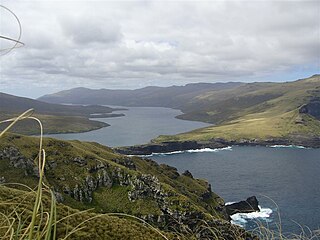
Auckland Island is the main island of the eponymous uninhabited archipelago in the Pacific Ocean. It is part of the New Zealand subantarctic area. It is inscribed in the UNESCO World Heritage list together with the other New Zealand Subantarctic Islands in the region.

Campbell Island / Motu Ihupuku is an uninhabited subantarctic island of New Zealand, and the main island of the Campbell Island group. It covers 112.68 square kilometres (43.51 sq mi) of the group's 113.31 km2 (43.75 sq mi), and is surrounded by numerous stacks, rocks and islets like Dent Island, Folly Island, Isle de Jeanette-Marie, and Jacquemart Island, the latter being the southernmost extremity of New Zealand. The island is mountainous, rising to over 500 metres (1,640 ft) in the south. A long fiord, Perseverance Harbour, nearly bisects it, opening out to sea on the east coast.
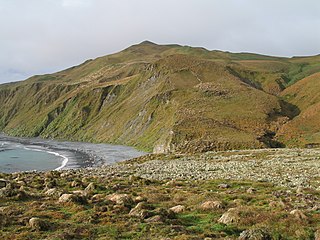
The Antipodes Subantarctic Islands tundra ecoregion, within the tundra biome, includes five remote island groups in the Pacific Ocean south of New Zealand: the Bounty Islands, Auckland Islands, Antipodes Islands and Campbell Island groups of New Zealand, and Macquarie Island of Australia.

Bidens frondosa is a North American species of flowering plant in the aster family, Asteraceae. It is widespread across much of Canada, the United States, and Mexico It is known in many other parts of the world as an introduced species, including Europe, Asia, Morocco, and New Zealand. Its many common names include devil's beggarticks, devil's-pitchfork, devil's bootjack, sticktights, bur marigold, pitchfork weed, tickseed sunflower, leafy beggarticks, and common beggar-ticks.

Symphyotrichum lateriflorum is a species of flowering plant in the aster family (Asteraceae). Commonly known as calico aster, starved aster, and white woodland aster, it is native to eastern and central North America. It is a perennial and herbaceous plant that may reach heights up to 120 centimeters and widths up to 30 centimeters.
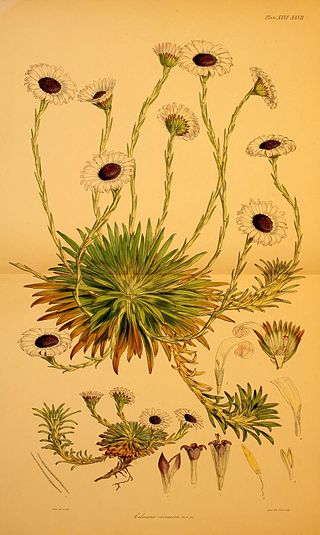
Damnamenia is a genus of flowering plants in the family Asteraceae.

Pleurophyllum is a genus of subantarctic plants in the tribe Astereae within the family Asteraceae.

Celmisia spectabilis, also known as cotton daisy or by its Māori name puharetaiko, is a mountain daisy in the family Asteraceae, and is endemic to New Zealand, where it is one of the most widespread species in the genus Celmisia.

Pleurophyllum hookeri, also known as the silver-leaf daisy or sage-green rosette herb, is a herbaceous plant in the family Asteraceae, a megaherb native to the subantarctic Auckland and Campbell Islands of New Zealand and Australia’s Macquarie Island. It grows up to 900 mm in height and has crimson button flowers and long, silky, silver leaves, with a large carrot-like tuber and long roots. It also has the unusual feature of a vertically contractile stem, most of which is underground, which serves to keep the leaf rosette close to the ground surface and the plant anchored securely against the very strong winds typical of subantarctic islands. Prior to the successful eradication of introduced mammals on Macquarie Island in 2011, it had been threatened there by black rats and European rabbits.

Luzula crinita is a species of flowering plant in the rush family that is native to the subantarctic islands of New Zealand and Australia. The specific epithet comes from the Latin crinitus, with reference to the leaves.
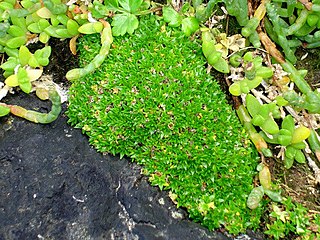
Colobanthus muscoides is a low-growing, moss-like flowering cushion plant in the family Caryophyllaceae, found on islands in the south-western Pacific Ocean, especially in the subantarctic region. The specific epithet comes from the Latin muscus (moss) and -oides (resembling), with reference to its growth habit.

Bulbinella rossii, commonly known as the Ross lily, is a species of flowering plant in the genus Bulbinella. Despite its common name, it does not belong to the lily family Liliaceae. It is one of the subantarctic megaherbs. The specific epithet honours British Antarctic explorer James Clark Ross, who visited Campbell Island in December 1840. Bulbinella rossii is featured on the reverse of the current five dollar New Zealand banknote.

Anisotome latifolia, commonly known as the Campbell Island carrot, is a species of plant in the genus Anisotome of the carrot family (Apiaceae). It is native to the Auckland and Campbell Islands in the subantarctic regions of the South Pacific.

Cassinia arcuata, commonly known as drooping cassinia, biddy bush, Chinese scrub, sifton bush and Chinese shrub, is a species of flowering plant in the family Asteraceae and is endemic to Australia. It is a shrub, sometimes a small tree with sessile, linear leaves, and heads of up to two hundred brownish flowers arranged in pyramid-shaped panicles. In New South Wales, the species is known as Cassinia sifton. In disturbed areas, C. arcuata can become weedy.

Galium antarcticum, commonly known as Antarctic bedstraw or subantarctic bedstraw, is a species of flowering plant in the coffee family. It has a largely subantarctic range.

Dracophyllum arboreum, commonly known as Chatham Island grass tree and tarahinau (Moriori), is a species of tree in the heath family Ericaceae. Endemic to the Chatham Islands of New Zealand, it reaches a height of 18 m (60 ft) and has leaves that differ between the juvenile and adult forms.
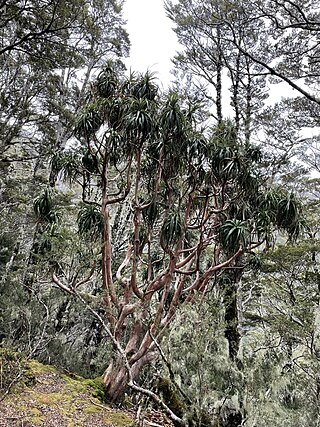
Dracophyllum traversii, commonly known as mountain neinei, grass tree, and pineapple tree is a species of flowering plant in the heath family Ericaceae. It is a deciduous tree endemic to New Zealand. It reaches a height of 0.2–13 m (0.66–42.65 ft) and has leaves which form tufts at the end of its branches. It has a lifespan of between 500 and 600 years.

Megaherbs are a group of herbaceous wildflowers growing in the New Zealand subantarctic islands and on the other subantarctic islands. They are characterised by their great size, with huge leaves and very large and often unusually coloured flowers, which have evolved as an adaptation to the harsh weather conditions on the islands. They suffer from overgrazing due to introduced mammals.

Ichneutica erebia is a moth of the family Noctuidae. This species is endemic to New Zealand and is found on Campbell Island and the Auckland Islands. Adults of this species are on the wing from August to January. The adults are variable in appearance but can be distinguished from similar species by the patters or lack thereof on their forewings. The larvae of I. erebia are polyphagous and hosts include Pleurophyllum criniferum, species within the genera Stilbocarpa and Carex, as well as Chionochloa antarctica, Urtica australis and Raukaua simplex.




















